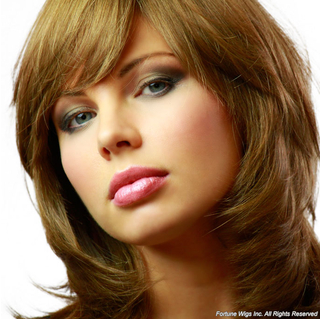 For many women suffering from alopecia areata, wigs are certainly something to think about. Choosing to wear a wig can do wonders for your self-image and your self-confidence. When many women look in the mirror, seeing hair makes them feel complete and as they want to look.
For many women suffering from alopecia areata, wigs are certainly something to think about. Choosing to wear a wig can do wonders for your self-image and your self-confidence. When many women look in the mirror, seeing hair makes them feel complete and as they want to look.
Whether you have been wearing a wig for years, or you are just starting to do research to find the right wig for you, we know you are going to have a lot of questions.
This is the start of an on-going series where we ask some of your most common questions to leading wig manufacturers in the industry. Today, we talk with BGDL 2013 Sponsor Fortune Wigs Inc, a family owned and operated company that specializes in human hair wigs for women.
What regions and countries (exactly) is hair sourced from? Is that different from 5 or 10 years ago?
In general, the 4 main sources for hair are Asia (China & Mongolia), India, Eastern Europe (Russia & Ukraine) and South America. Five to ten years ago, higher end human hair wigs and hair-pieces were made exclusively from Eastern European hair and more budget friendly options were made mostly with Indian hair. The landscape has shifted since and South American hair now takes a prominent role in the higher end market while Asian hair has made big inroads on the lower end of the spectrum.
The shift to South American hair is due primarily to the rising price and reduced availability of Eastern European hair. Prices have gone up because of increased demand for hair extensions which are sold at a higher markup than hair-pieces and cost less to produce. Even when money is not an object, Eastern European hair is harder to come by. Due to the increased affluence of the local populations, less women are willing to cut their hair off altogether.
The confluence of the increased demand created by the hair extension market and the decreased supply overall has caused a shift toward South American hair which is much more readily available.
The reason for the shift toward Asian sources for human hair is much different. The availability and cost of Asian and Indian hair are very similar. About ten years ago, it became widely known in Orthodox Jewish circles that much of the Indian hair on the market was sold by Hindu temples where women would donate the hair as a religious sacrifice.
Jewish law forbids benefit from idol worship. Since many Jewish authorities forbade using wigs made with Indian hair, many Jewish manufacturers no longer use Indian hair. Fortune Wigs does not use Indian hair for this reason. In fact, our company has a rabbinic “kosher” certification that guarantees our wigs to be free of Indian hair for those who are concerned.
What is meant by the phrase European Hair?
“European Hair” by industry terms simply means hair trimmed off the head of a person of European decent. Much of the “European Hair” available today comes from South America.
When the manufacturer gets the hair, what is the process used to sort? What exactly does Virgin Hair go through before it reaches the customer?
Natural hair grows in varying lengths. Wigs are often created from hair of all one length. Even when more than one length is used, the wig maker still will use only one length of hair at a time as they “layer” the wig, so the first step is to sort the hair by length. During this process, we will also take the opportunity to remove any hairs that are damaged or otherwise not up to standard. The hair is placed into bundles separated by length which is then tied into a larger bundle that includes the entire ponytail with all the lengths so you end up with a bunch of smaller bundles inside of a larger bundle of hair.
For virgin hair that is not color processed, the “processing” stops right there and the hair is then sewn into a wig or hair-piece.
How do you color the hair to make it all uniform, say, 27 or 30?
For hair that will be processed for color, it is first stripped of all pigmentation and becomes translucent. Only after all the color is removed is the hair dyed to our pre-defined color ring colors.
We will dye wigs to basic colors like 2 or 4 which are just one color. We can also do percentages (i.e. 40% #2, 50% #6, and 10% #10). Or we do highlighted colors which will consist primarily of one color as a “base color” and then have highlights added in on top. Most of our stock colors are either single colors or highlighted colors. Blended colors are usually special order and take about 6 weeks to come in.
Of course, precise color matching is not a simple task with virgin hair that is not dyed to uniform colors since natural hair grows in an endless number of shades and colors.
What chemicals are used to color hair? Rumor is some factories use fabric dye which is impossible to color over.
For our darker colors, we use hair-dyes (not fabric dyes). Lighter colors are achieved with bleaching. I can’t speak for other manufacturers who use fabric dyes. I do know that we regularly re-dye our wigs successfully for clients (if the client decides to go for a color change or if the hair has oxidized due to exposure to the sun).
I would mention that dyeing or adding highlights to lighter colors is risky since they have been bleached and color may not take or may take in a very unpleasant way. For that reason, we do not recommend coloring our lighter Asian hair wigs. If you do, make sure to test it on a few strands first.
Why do wig manufacturers coat hair with silicone? Does that mean the wearer needs to take extra precautions in taking care of it especially during the first year?
This tends to be done with color processed hair. It gives the hair extra shine and makes it feel more silky. Eventually, it will wear off. Extra care would be less washing. Don’t wash it more often than necessary (unless you don’t like the silicone).
Thank you to Fortune Wigs for answering our questions! We have more answers from them, as well as other manufacturers, that we will be publishing in future blog updates. Be sure to sign up below so you don't miss out on any of this series!

